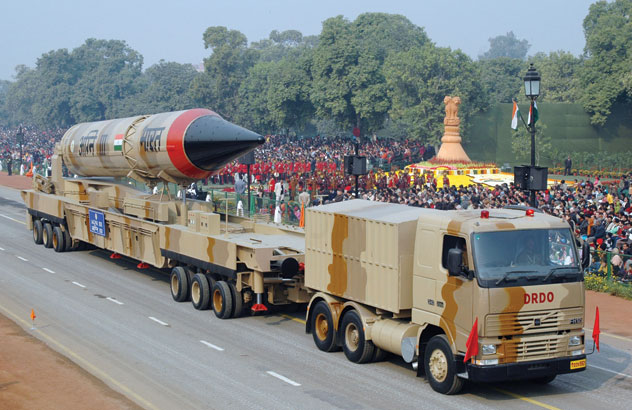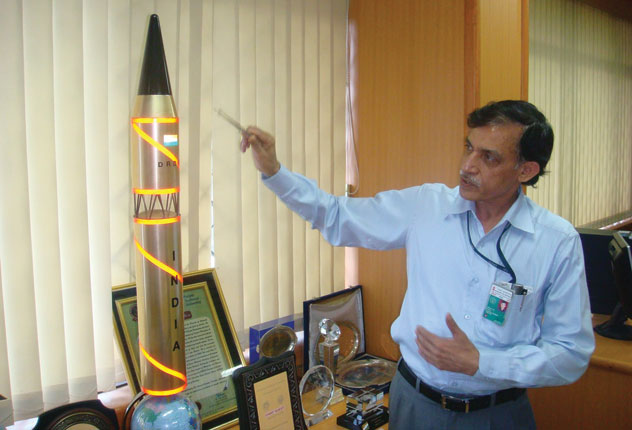SUBCONTINENT:
Range Extended: India's Missile Program
Earlier this month, India successfully tested the surface to surface 3,500 Km range Agni-IV ballistic missile setting the platform to acquire Inter Continental Ballistic Missile (ICBM) capabilities via the Agni-V that brings even northern China into range, writes Siddharth Srivastava.

(Above): File photo of the Agni-III missile on display at India’s Republic Day parade.
Following the success of Agni-IV, India has announced that its first ICBM, the Agni-V, will be test fired “within the December-February time-frame.” So far ICBMs, with capability to strike targets 5,500 Km away, are possessed by select countries like the United States, China, Britain and Russia.
Agni program director Avinash Chander said that Agni-V would be ready for induction to the armed forces by 2014, while Agni-IV will be operational by 2013 after two to four more “repeatable” tests. “Our aim is to take just two to three years from the first test to the induction phase,” he said.
Explaining the strategy behind India’s missile program, the chief of DRDO, the nodal federal body that oversees the country’s indigenous arms development, V.K. Saraswat said, “We are not looking at how many missiles China or Pakistan has. With a ‘no first-use’ nuclear weapons policy, we only want a sufficient number of missiles to defend the country in the event of a crisis. Ours is a defensive-mode strategy, even if others have offensive postures.”
India’s two-decade-old ballistic missile program capable of delivering nuclear warheads, has mostly aimed to nullify the threat from immediate neighbor Pakistan.
India’s Agni missile series are the result of decade long research. DRDO claims it is built with nearly 95-98% indigenous technology, though Indian scientists are known to copy readily available blueprints from Russia.
In the recent past, however, there have been strong indications that New Delhi is keen to extend this program to bring within its attack ambit, China. While Prithvi and shorter versions of Agni missile series cover Pakistan, Agni III and beyond is part of India’s efforts to guard against China.
The ICBM is referred by Indian officials and scientists as “China Killer” due to its ability to target cities such as Beijing, Shanghai and reach the northern most tips of the country.
Earlier this year, Air Chief Marshal P.V. Naik (now retired) said India’s rising global stature demands developing ICBM and long range attack capabilities possessed by elite nations.

(Above): Agni program director Avinash Chander
“India should pursue an ICBM program to acquire ranges of 10,000 km or even more. Breaking out of the regional context is important as the country’s sphere of influence grows. We have no territorial designs on any country, but India needs the capability to match its sphere of influence,” Naik said.
Coincidentally India’s deepening interest in ICBMs has happened even as the United States has opened its defense armaments market, including dual use technology, for Indian use, definitely moving away from a sanctions’ ridden policy paradigm that harked by to the Cold War era when India was aligned with the erstwhile Soviet Union.
Events such as the 1999 Kargil War during which the country nearly went to war with Pakistan and the November 2008 Mumbai terror attacks orchestrated by Pakistan-based Lashkar-e-Toiba terrorists, have only heightened India’s insecurities and refine its ability to attack and protect itself.
Since the Mumbai attacks in November 2008, India has also accelerated its ballistic missile defense (BMD) program to protect against a sudden missile attack, possibly nuclear tipped, particularly from rogue elements in Pakistan.
The BMD expertise can also be extended to space to protect India’s remote and communication satellites especially in the context of China conducting an anti-satellite test in 2007, in what is seen as a potential “star wars” arms race between the two Asian nations, with the United States strategically sided with India.
Yet, India has a long way before it can match up to China’s arsenal, with its missiles capable of delivering payloads up to 14,000 kms, essentially covering most of the globe. Pakistan is no bunny either with its missile program actively promoted by China. The country has test-fired the Shaheen-2, which is a 2,000 Km range ballistic missile.
Pakistan, meanwhile, continues to receive military largess from the U.S. as a partner in the global war against terror, though India has for long held that such stock piling of weapons only add to instability in the region.
New Delhi feels that U.S.-supplied armaments to Pakistan are more potent against a conventional enemy rather than the amorphous terror networks that also spread over Afghanistan and need effective intelligence and pin pointed operations, such as the one that killed Osama Bin-Laden, to neutralize.
India has thus been implementing a massive defense modernization effort over the past few years. Given the country’s incipient domestic abilities to manufacture military hardware, most arms are being imported, though the missile program remains an indigenous effort that maps successes in India’s space program.
In its latest report, Swedish think tank Stockholm International Peace Research Institute, has said that India is the biggest arms importer in the world and in the process overtaken China, though Indian observers say that a major portion of Beijing’s arms budget continues to be hidden, secret and unknown to the world.
|